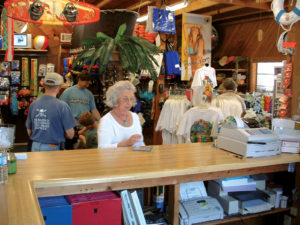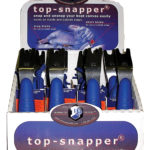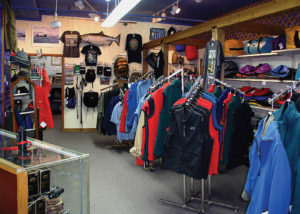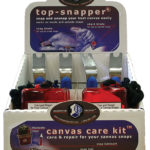Adding a retail component to your marine fabrication business

Adding a retail component to your business can become an essential part of your life as a shop owner. And with enough planning and foresight, the process can help you to transition smoothly into the next phase of your blossoming fabrication business.
Whether you are just starting out in the marine fabrication industry or are a longtime shop owner, there comes a time when the inevitable questions arise: How can I grow my business, and is there more I could be doing for my customers? Some owners respond by offering discount programs for loyal customers, relocating to a bigger shop, or finding new and creative ways to market their business. But, shop owners are learning that the key to better customer service and bigger profits is the addition of a retail component.
Adding a retail section to an existing fabrication business can be as easy as selling a few cleaning products and supplies to customers, or as complex as opening a whole new storefront. After talking with successful retail shop owners and suppliers from across the country, we’ve compiled a step-by-step guide to jump-starting your own retail business. If approached wisely, the process of evolving your business to include this component is easier than you might expect.
Getting started
Deciding to add a retail component to your business is an important step, but there are many decisions to be made before you begin. First, consider the current layout of your shop and decide whether you have the space. For Kate Mitchell, owner of Nomar in Homer, Alaska, the decision to add retail space was easy because she was in the process of moving into a larger space.

Whether you start small or add a wide variety of products from the beginning, it’s important to stay organized as your retail business takes off.
“We were primarily a boat top and upholstery shop working in a boat storage yard,” she explains. “There was this old grocery store building sitting empty, it was right downtown with large work space and retail potential, concrete floors, indoor plumbing, running water. We bid on the building and got it.”
Once she had moved into the new space, Mitchell started small by adding only a few retail items at a time. “In the beginning, we brought in a few things that Alaskan fishermen need, like boots and rain gear, to complement the items we make. We retailed the fabric and supplies we use to the do-it-yourselfers; we added patterns and additional sewing supplies the community needed. We were very conservative, with small-town quantities.”
After you decide where to display your retail items, it is necessary to decide what to sell. Deciding what to stock often depends on the demands of the community that your shop services, and retail items can range from maintenance supplies and cleaners to outdoor gear and sporting goods.

Even though selling key lime pie at a marine fabrication business may seem odd, Lyon Kerby, owner of SeaLyon Marine Canvas, has unlocked the secret to retail success: offer customers a product that they can’t get anywhere else.
Lyon Kerby, owner of SeaLyon Marine Canvas in Counce, Tenn., says that the biggest factor in deciding what to sell was the information he gathered from Surf Expo. Held every January and September at the Orange County Convention Center in Orlando, Fla., Surf Expo is a trade show that showcases thousands of vendors. The show gives retailers a chance to meet potential suppliers and get an up-close look at the products available for retail in the marine industry. “That was a great place to get contacts and meet suppliers,” explains Kerby, who says that his attendance at Surf Expo helped cultivate many of the contacts that he still relies on.
Establishing good connections with suppliers is essential to cultivating a retail business. Because suppliers work with a variety of retailers, they have the knowledge and experience to give you advice as you start to add retail products. According to Tom Koster of Tri Vantage, a North Carolina-based distributor of marine parts and accessories, most suppliers will be more than happy to assist retailers with their important first decisions. “Any good supplier understands that we are here to help the customer prosper,” he says. “If the customer isn’t making money, then neither the supplier nor the customer can make money in the long term. Our long-term goals are to provide information, materials and services that make it possible for the customer to be profitable.”
Koster says that developing a good working relationship with a customer service representative is key. “If retailers don’t know what they want,” he says, “they should know what it is they are trying to accomplish, and then an experienced customer service rep can walk them through their best options.” When asked what advice he could give to novice retail shop owners who are building relationships with suppliers, Koster had one reply: “Communicate.”
Maintaining your retail space

The building’s nautical design was perfect fit for SeaLyon Marine Hut. Most of the space is devoted to the retail portion of the business, but a small canvas room sits off to the side. Since moving to a location that shares a site with boat storage, SeaLyon has seen a surge in summer business.
Whether you start small or add a wide variety of products from the beginning, it’s important to stay organized as your retail business takes off. In addition to the typical workload of balancing fabricating projects and maintaining business records, retail owners need to keep a handle on how many items they have sold and how often they need to replenish their stock.
Kerby recommends taking stock of your retail inventory as often as possible. He says his company faced huge challenges in their first year of retail sales. “We didn’t take inventory until the end of the year, and it was a disaster,” he says. “Now we try to take inventory once a month, whenever we have the time. The ultimate goal would be to have a register that tracks items when you scan them to ring them up, but we aren’t that high tech yet.”
Managing an inventory and keeping track of supply orders can become an overwhelming task for owners, especially if their retail business is growing rapidly. Many shops find it necessary to hire additional staff members to help ease the workload of managing retail space, and finding someone to help run the retail component of your shop can also help you to organize other parts of your business.
“I used to do all the ordering,” explains Mitchell. “Now our retail department has a manager that does most of the ordering. The advantage of a retail area is that you have an employee whose job is to greet and assist the customer as they come in. They can handle some of the traffic while you produce. You don’t have to talk with everyone. We also have our retail people sew, do minor repairs, make straps and simple components, as their time allows.”
Because many shops choose to add a retail component as a way to offer better customer service, it’s important to familiarize yourself with the products you sell. Marianne Iosso of Iosso Products, which supplies fabric cleaning products to a wide base of marine fabricators, says the most important part of running a successful retail business is choosing products that you feel confident selling. “To know something really good that really works and be able to supply it, to me, offers very good customer service,” Iosso says. “Then the customer will say, ‘Hey, they knew what to tell me, what to do with it, and they gave me this really good stuff that worked.’ And they know where to get it next time.”
Moving forward
Kerby has a card up his sleeve when it comes to marketing his business, and it has nothing to do with his fabricating services or recreational products. “We started offering key lime pie,” he says with a laugh. “I make a homemade key lime pie that has people licking the pan. We have more people coming in for pies than anything else. We have a lot of repeat customers because of the pie.”
-

- Establishing good connections with suppliers is essential to cultivating a retail business. According to Tom Koster of Tri Vantage most suppliers will be more than happy to assist retailers with their important first decisions.
Though it may seem odd, Kerby has unlocked the secret to retail success: offer customers a product that they can’t get anywhere else. If you live in a larger city with lots of big box retail stores, find products that are unique to your store and services. If you work in a small community, find out what kind of demand there is for marine products, and tailor your store to the customers you want to attract.
And, never assume that your work is done in terms of marketing your business and putting your shop on customers’ radar. “We have been here for nine years,” Kerby says, “and we still have people who say, ‘We didn’t know you were here.’”

For Kate Mitchell, owner of Nomar, the decision to add retail space was easy because she was in the process of moving into a larger building. Once she had moved into the spaces, Mitchell started small by adding only a few retail items at a time.
The evolution of your business depends solely on the work you put into promoting it, and shop owners across the board agree that the hard work and effort of setting up a retail component have significantly benefited their businesses in the long term, both financially and creatively.
Mitchell of Nomar says that adding a retail component has given her the freedom to pursue more challenging projects. “With retail elements in place and a year-round cash flow, we have the luxury of getting to take those unusual, custom, engineered projects that don’t always pencil out to a bean counter, but give creative juices a chance to flow.”
Whatever your reasons for adding a retail component to your business, it can become an essential part of your life as a shop owner. And with enough planning and foresight, the process can help you to transition smoothly into the next phase of your blossoming fabrication business.
 TEXTILES.ORG
TEXTILES.ORG 







